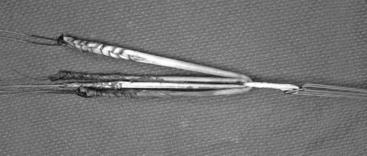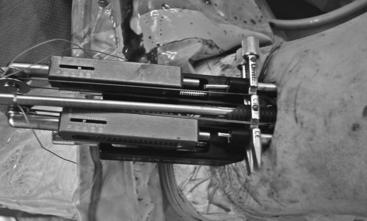Chapter 45 Anterior Cruciate Ligament Hamstring Graft Fixation with BioScrew XtraLok Tibial Fixation Device
Introduction
The fixation of soft tissue grafts and the four-bundle hamstring grafts have been the weak point of the anterior cruciate ligament (ACL) hamstring graft fixation. Kousa et al1 and Brand et al2 have published laboratory studies to provide some guidance in selecting the strongest fixation device. On the femoral side the cross-pins and closed-loop Endobutton are more than double the strength needed for activities of daily living (1000N versus 450N). The tibial side remains the weak part of the construct. The IntraFix device (DePuy Mitek, Norwood, MA) has been reported to be around 1000N, and the staples on the cortex approximately 500N. Harvey et al3 demonstrated that screws with cortical fixation were almost twice the strength of screws that were placed in the cancellous bone portion of the tunnel. This presentation will describe the technique of using a cortical cancellous screw fixation for the four-bundle hamstring graft.
Fixation of the Graft in the Tibial Tunnel
The four-bundle graft is pulled up through the tibial tunnel with the leader sutures attached to the Endobutton (Fig. 45-1). The graft is pulled 3 cm into the femoral tunnel. The Endobutton is flipped on the periosteal surface of the femur. The graft is pulled distally so that approximately 1 cm of graft is protruding out of the tibial tunnel.
The flexible guidewire is inserted into the middle of the four bundles, and the XtraLok BioScrew (Conmed/Linvatec, Largo, FL) is inserted up the middle of the four bundles (Fig. 45-2). The stability of the knee is measured at the end of the fixation and compared with the preoperative manual maximum measurement of the opposite knee.
1 Kousa P, Jarvinen TL, Vihavainen M, et al. The fixation strength of six hamstring tendon graft fixation devices in anterior cruciate ligament reconstruction. Part II: tibial site. Am J Sports Med. 2003;31:182-188.
2 Brand JJr, Weiler A, Caborn DN, et al. Graft fixation in cruciate ligament reconstruction. Am J Sports Med. 2000;28:761-774.
3 Harvey AR, Thomas NP, Amis AA. The effect of screw length and position on fixation of four-stranded hamstring grafts for anterior cruciate ligament reconstruction. Knee. 2003;10:97-102.









